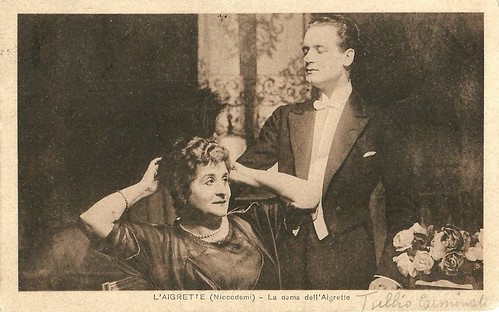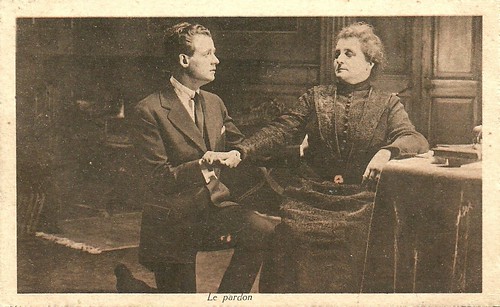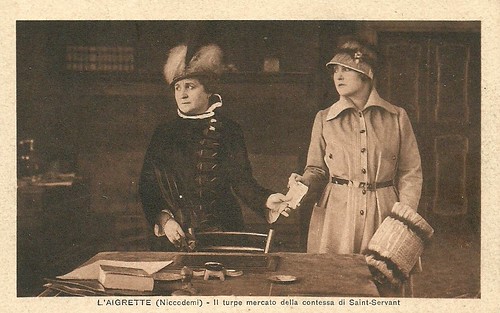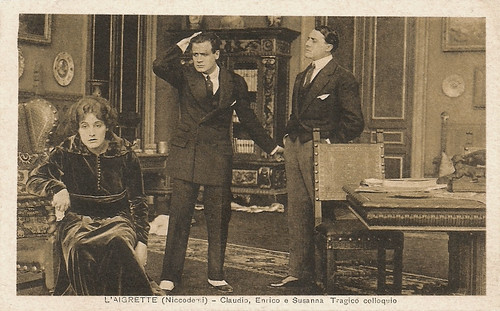L'aigrette/The egret (1917) is a silent Italian film by Baldassare Negroni. The film, produced by Tiber Film in Rome, was an adaptation by Negroni of a stage play by Dario Niccodemi. Stars were Hesperia, Tullio Carminati and André Habay.

Italian postcard by IPA CT Duplex, no. 5102. Photo: Tiber Film. André Habay in L'aigrette/The egret (Baldassarre Negroni, 1917), based on the play by Dario Niccodemi. Caption: Intimity.

Italian postcard by IPA CT Duplex, no. 5103. Photo: Tiber Film, Roma. Tullio Carminati and Ida Carloni Talli in L'aigrette (Baldassarre Negroni, 1917). Caption: The lady of the egret.

Italian postcard by IPA CT Duplex, no. 5104. Photo: Tiber Film. Tullio Carminati and Ida Carloni-Talli in L'aigrette (Baldassarre Negroni, 1917). Caption: The pardon.

Italian postcard by IPA CT Duplex, no. 5105. Photo: Tiber Film, Roma. Hesperia (at right) and Ida Carloni Talli in L'aigrette (Baldassarre Negroni, 1917). Caption: The vile market of the Countess of Saint-Servant.
The countess of Saint-Servant (Ida Carloni Talli) has raised her son Enrico (Tullio Carminati) to be proud of his name and title and to cherish honour and virtue, symbolised by the feather of her aigrette (egret). In reality, the countess is hunted by creditors, the castle is falling apart.
Enrico falls in love with Susanne Leblanc (Hesperia), wife of a banker, and, unknowing to Enrico, in return, she loads his mother with money in order to restore the family castle and pay off the many debts.
Her husband Claudio (André Habay) is not so happy with this kind of charity and reveals to Enrico that he and his mother have been living on his lover's expenses for years. Enrico is devastated, as his image of his mother and his lover collapses.
It's not entirely clear how the film proceeds, but Dario Niccodemi's play tells Enrico has a fatal confrontation with his mother about the lies and gifts, but she answers she did all this for him only.
Finally, Susanna succeeds in preventing Enrico to kill himself and to come to his senses. He will flee with her, and start a life of working.

Italian postcard by IPA CT Duplex, no. 5106. Photo: Tiber Film. Ida Carloni Talli in L'aigrette (Baldassarre Negroni, 1917). Caption: The Countess of Saint-Servant in the grip of her creditors.

Italian postcard by IPA CT Duplex, no. 5107. Photo: Tiber Film, Roma. André Habay and Hesperia in L'aigrette (Baldassarre Negroni, 1917). Caption: The Leblanc family in happier days.

Italian postcard by IPA CT Duplex, no. 5108. Photo: Tiber Film. Hesperia, Tullio Carminati and André Habay in L'aigrette (Baldassarre Negroni, 1917). Caption: Claudio, Enrico, and Susanna. Tragic conversation.
L'aigrette was written as a comedy in three acts in 1912 and had been the first play by Dario Niccodemi. His comedies represent the bourgeois drama in an ironic and sentimental way, in which his characters are modeled on the society of the beginning of the century.
Niccodemi wrote several plays and screenplays. Films based on his work include L'ombra/The shadow (Mario Caserini, 1917) with Vittoria Lepanto, La nemica/The enemy (Ivo Ulliminati, 1917) and Scampolo, filmed in 1917 with Margot Pellegrinetti, in 1928 with Carmen Boni, in 1932 with Dolly Haas, in 1941 with Lilia Silvi, and in 1958 with Romy Schneider.
L'aigrette has a wonderful cast with stars of the silent Italian cinema, like Tullio Carminati, André Habay, Diomira Jacobini, Ida Carloni Talli, and of course in the leading role Hesperia.
Tullio Carminati (1895-1971) had a long-standing career from the 1910s to the 1960s. He played in Italian, German, American, British, and French films as well as on Italian, American and British stages.
André Habay (1883-1941) aka Andrea Habay (also written as Habaj or Kabaj) acted in modern dramas and in diva films such as Sangue blu/Blue Blood (Nino Oxilia, 1914) and Rapsodia satanica/Satan's Rhapsody (Nino Oxilia, 1917). Later, he also starred as Petronius in the epic Quo vadis? (Gabriellino D'Annunzio, Georg Jacoby, 1925).
Ida Carloni Talli (1860-1940) was a well-known Italian stage actress, who also acted in 92 Italian silent films. And Hesperia (1885-1959), was one of the greatest divas of the Italian silent screen. She often worked with director Baldassarre Negroni, who later became her husband.

Italian postcard by IPA CT Duplex, no. 5109. Photo: Tiber Film. André Habay in L'aigrette (Baldassarre Negroni, 1917) Caption: Claudio doing business at the stock exchange.

Italian postcard by IPA CT Duplex, no. 5110. Photo: Tiber Film. Hesperia, Ida Carloni Talli, and probably Diomira Jacobini in L'aigrette (Baldassarre Negroni, 1917). Caption: The countess of Saint-Servant (Talli) presents Susanna (Hesperia) the young duchess of Frontenac (Jacobini).

Italian postcard by IPA CT Duplex, no. 5111. Photo: Tiber Film. Tullio Carminati and probably Diomira Jacobini in L'aigrette (Baldassarre Negroni, 1917). Caption: Enrico and his fiancee, the duchess of Frontenac.
Sources: Dario Niccodemi (L'aigrette - Italian), Vittorio Martinelli (Il Cinema Muto Italiano, vol. 1917), Wikipedia (Italian) and IMDb.
This post was last updated on 9 February 2021.

Italian postcard by IPA CT Duplex, no. 5102. Photo: Tiber Film. André Habay in L'aigrette/The egret (Baldassarre Negroni, 1917), based on the play by Dario Niccodemi. Caption: Intimity.

Italian postcard by IPA CT Duplex, no. 5103. Photo: Tiber Film, Roma. Tullio Carminati and Ida Carloni Talli in L'aigrette (Baldassarre Negroni, 1917). Caption: The lady of the egret.

Italian postcard by IPA CT Duplex, no. 5104. Photo: Tiber Film. Tullio Carminati and Ida Carloni-Talli in L'aigrette (Baldassarre Negroni, 1917). Caption: The pardon.

Italian postcard by IPA CT Duplex, no. 5105. Photo: Tiber Film, Roma. Hesperia (at right) and Ida Carloni Talli in L'aigrette (Baldassarre Negroni, 1917). Caption: The vile market of the Countess of Saint-Servant.
Cherishing Honour and Virtue
The countess of Saint-Servant (Ida Carloni Talli) has raised her son Enrico (Tullio Carminati) to be proud of his name and title and to cherish honour and virtue, symbolised by the feather of her aigrette (egret). In reality, the countess is hunted by creditors, the castle is falling apart.
Enrico falls in love with Susanne Leblanc (Hesperia), wife of a banker, and, unknowing to Enrico, in return, she loads his mother with money in order to restore the family castle and pay off the many debts.
Her husband Claudio (André Habay) is not so happy with this kind of charity and reveals to Enrico that he and his mother have been living on his lover's expenses for years. Enrico is devastated, as his image of his mother and his lover collapses.
It's not entirely clear how the film proceeds, but Dario Niccodemi's play tells Enrico has a fatal confrontation with his mother about the lies and gifts, but she answers she did all this for him only.
Finally, Susanna succeeds in preventing Enrico to kill himself and to come to his senses. He will flee with her, and start a life of working.

Italian postcard by IPA CT Duplex, no. 5106. Photo: Tiber Film. Ida Carloni Talli in L'aigrette (Baldassarre Negroni, 1917). Caption: The Countess of Saint-Servant in the grip of her creditors.

Italian postcard by IPA CT Duplex, no. 5107. Photo: Tiber Film, Roma. André Habay and Hesperia in L'aigrette (Baldassarre Negroni, 1917). Caption: The Leblanc family in happier days.

Italian postcard by IPA CT Duplex, no. 5108. Photo: Tiber Film. Hesperia, Tullio Carminati and André Habay in L'aigrette (Baldassarre Negroni, 1917). Caption: Claudio, Enrico, and Susanna. Tragic conversation.
A Wonderful Cast
L'aigrette was written as a comedy in three acts in 1912 and had been the first play by Dario Niccodemi. His comedies represent the bourgeois drama in an ironic and sentimental way, in which his characters are modeled on the society of the beginning of the century.
Niccodemi wrote several plays and screenplays. Films based on his work include L'ombra/The shadow (Mario Caserini, 1917) with Vittoria Lepanto, La nemica/The enemy (Ivo Ulliminati, 1917) and Scampolo, filmed in 1917 with Margot Pellegrinetti, in 1928 with Carmen Boni, in 1932 with Dolly Haas, in 1941 with Lilia Silvi, and in 1958 with Romy Schneider.
L'aigrette has a wonderful cast with stars of the silent Italian cinema, like Tullio Carminati, André Habay, Diomira Jacobini, Ida Carloni Talli, and of course in the leading role Hesperia.
Tullio Carminati (1895-1971) had a long-standing career from the 1910s to the 1960s. He played in Italian, German, American, British, and French films as well as on Italian, American and British stages.
André Habay (1883-1941) aka Andrea Habay (also written as Habaj or Kabaj) acted in modern dramas and in diva films such as Sangue blu/Blue Blood (Nino Oxilia, 1914) and Rapsodia satanica/Satan's Rhapsody (Nino Oxilia, 1917). Later, he also starred as Petronius in the epic Quo vadis? (Gabriellino D'Annunzio, Georg Jacoby, 1925).
Ida Carloni Talli (1860-1940) was a well-known Italian stage actress, who also acted in 92 Italian silent films. And Hesperia (1885-1959), was one of the greatest divas of the Italian silent screen. She often worked with director Baldassarre Negroni, who later became her husband.

Italian postcard by IPA CT Duplex, no. 5109. Photo: Tiber Film. André Habay in L'aigrette (Baldassarre Negroni, 1917) Caption: Claudio doing business at the stock exchange.

Italian postcard by IPA CT Duplex, no. 5110. Photo: Tiber Film. Hesperia, Ida Carloni Talli, and probably Diomira Jacobini in L'aigrette (Baldassarre Negroni, 1917). Caption: The countess of Saint-Servant (Talli) presents Susanna (Hesperia) the young duchess of Frontenac (Jacobini).

Italian postcard by IPA CT Duplex, no. 5111. Photo: Tiber Film. Tullio Carminati and probably Diomira Jacobini in L'aigrette (Baldassarre Negroni, 1917). Caption: Enrico and his fiancee, the duchess of Frontenac.
Sources: Dario Niccodemi (L'aigrette - Italian), Vittorio Martinelli (Il Cinema Muto Italiano, vol. 1917), Wikipedia (Italian) and IMDb.
This post was last updated on 9 February 2021.
No comments:
Post a Comment